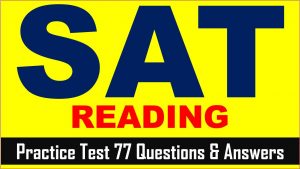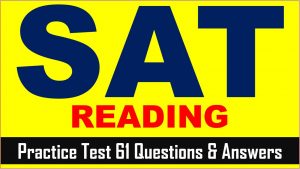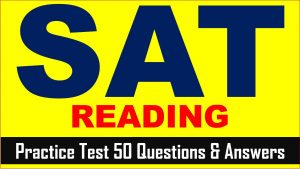Hi SAT Aspirants, welcome to AKVTutorials. As you know SAT (Scholastic Assessment Test) is a standard test, used for taking admission to undergraduate programs of universities or colleges of United States. SAT is developed and published by the College Board, an organization in United States, administered by the Educational Testing Service. Are you searching for SAT Reading Practice Questions? Then, in this article of AKVTutorials, you will get SAT Reading Course Test 59 | SAT 2024 Online Tutor AMBiPi
SAT Reading Practice Passage
SAT Reading Practice Test Comprehensive Passage
This passage is adapted from “Fixed Opinions, or The Hinge of History” first published in 2003. The following 10 multiple choice questions are based on this passage below.
| I found in New York. in other words, that the afire event had |
|
| been seized—even as the less nimble among us were still |
|
| trying to assimilate it—to stake new ground in old domestic |
|
| Line wars. There was the frequent deployment of the phrase “the | |
| Line 5 | Blame America Firsters,” or “the Blame America First |
| crowd,” the wearying enthusiasm for excoriating anyone |
|
| who suggested that it could be useful to bring at least a | |
| minimal degree of historical reference to bear on the event. | |
| There was the adroit introduction of convenient straw men. | |
| Line 10 | There was Christopher Hitchens, engaging in a dialogue with |
| Noam Chomsky, giving himself the opportunity to generalize |
|
| whatever got said into “the liberal-left tendency to |
|
| ‘rationalize’ the aggression of September 11.” There was |
|
| Donald Kagan at Yale, dismissing his colleague Paul | |
| Line 15 | Kennedy as “a classic case of blaming the victim,” because |
| the latter had asked his students to try to imagine what | |
| resentments they might harbor if America what were small and the | |
| world dominated by a unified Arab-Muslim state. There was | |
| Andrew Sullivan, warning on his Web site that while the | |
| Line 20 | American heartland was ready for war, the “decadent left in |
| its enclaves on the coasts” could well mount “what amounts |
|
| to a fifth column.” |
|
| There was the open season on Susan Sontag—on a single |
|
| page of a single issue of the weekly standard that October | |
| Line 25 | she was accused of “unusual stupidity,” of “moral vacuity,” |
| sand of “sheer tastelessness”- all for three paragraphs in |
|
| which she said, in closing, that “a few sherds of historical |
|
| awareness might help us understand what has just happened. |
|
| and what may continue to happen; in other words that | |
| Line 30 | events have histories, political life has consequences, and the |
| people who led this country and the people who wrote and |
|
| spoke about the way this country was led were guilty of |
|
| trying to infantilize its citizens if they continued to pretend |
|
| otherwise. |
|
| Line 35 | into nature of the enemy we faced, in other words, was to be |
| interpreted as sympathy for that enemy. The final | |
| allowable word on those who attacked us was to be that they |
|
| were “evildoers,” or “wrongdoers,” peculiar constructions |
|
| which served to suggest that those who used them were | |
| Line 40 | transmitting messages from some ultimate authority. This |
| was a year in which it would come to seem as if we had been | |
| plunged at one fell stroke into a pre-modern world. The | |
| possibilities of the Enlightenment vanished. We had suddenly | |
| been asked to accept—and were in fact accepting—a kind of | |
| Line 45 | reasoning so extremely fragile that it might have been based |
| on the promised return of the cargo gods | |
| I recall early on, after John Ashcroft and Condoleeza Rice | |
| warned the networks not to air the bin Laden tapes because he | |
| he could be “passing information,” heated debate about the | |
| Line 50 | First Amendment implications of this warning—as if there |
| were even any possible point to the warning, as if we had all | |
| forgotten that our enemies as well as we lived in a world | |
| where information gets passed in more efficient ways. A year | |
| later, we were still looking for omens, portents, the | |
| Line 55 | supernatural manifestations of good or evil. Pathetic fallacy |
| was everywhere. The presence of rain at a memorial for | |
| fallen firefighters was gravely reported as evidence that | |
| “even the sky cried.” The presence of wind during a | |
| memorial at the site was interpreted as another such sign, the | |
| Line 60 | Spirit of the dead rising up from the dust. |
| This was a year when Rear admiral Stufflebeem, | |
| deputy director of operations for the joint chiefs of staff, | |
| would say at a pentagon briefing that he had been “a bit | |
| surprised” by the disinclination of the Taliban to accept of staff | |
| Line 65 | “inevitability” of their own defeat. It seemed that Admiral |
| Stufflebeem, along with many other people in Washington, | |
| had expected the Taliban to just give up. “The more that I | |
| look into it,” he said at this briefing, “and study it from the | |
| Taliban perspective, they don’t Taliban see the world the same way | |
| Line 70 | we do.” It was a year when the publisher of The Sacramento |
| Bee, speaking at the midyear commencement of California | |
| State University, Sacramento, would be forced off the stage | |
| stage of the Arco Arena for suggesting that because of the | |
| “validity” and “need” for increased security we would be | |
| Line 75 | called upon to examine to what degree we might be “willing |
| to compromise our civil liberties in the name of security.” | |
| Here was the local verdict on this aborted speech, as | |
| expressed in one of many outraged letters to the editor of the | |
| Bee: | |
| Line 80 | It totally and completely inappropriate for her to use this |
| opportunity to speak about civil liberties, military tribunals, | |
| terrorist attacks, etc. She should have prepared a speech | |
| about the accomplishments that so many of us had just | |
| completed. and the future opportunities that await us. |
SAT Reading Comprehension Practice Test Questions
SAT Reading Practice Test Question No 1
Which of the following best summarize the structure of the first paragraph?
Option A : A generalization is made and followed by its refutation
Option B : An issue is presented with an acknowledgment and a series of examples to its effect
Option C : An identification of two seemingly contradictory issues is ensued by later reconciliation
Option D : A phenomenon is recognized and analyzed theoretically
SAT Practice Test Answer No 1
Show/Hide Answer
Option A : A generalization is made and followed by its refutation
SAT Reading Practice Test Question No 2
The author suggests which of the following about using the phrase “the Blame America Firsters?”
Option A : It results in an unnecessary tendency to attack certain opinion-holders.
Option B : It dramatizes the profiles of dissenting crowds.
Option C : It brings more light on the issue than that of the leftists.
Option D : It mounts an assault on those who fry to rationalize the attack of September 11th
SAT Practice Test Answer No 2
Show/Hide Answer
Option A : It results in an unnecessary tendency to attack certain opinion-holders.
SAT Reading Practice Test Question No 3
In line 17, the word “harbor” is closest in meaning to
Option A : Contain
Option B : Welcome.
Option C : bear.
Option D : Insist.
SAT Practice Test Answer No 3
Show/Hide Answer
Option C : bear.
SAT Reading Practice Test Question No 4
The article suggests which of the following about Andrew Sullivan?
Option A : He never loses faith in the American Heartland.
Option B : Sides with Donald Kagan in his position against Paul Kennedy.
Option C : He denounces the leftist or the liberals with treacherous intents.
Option D : He considers those with opinions different from his as traitors of the state.
SAT Practice Test Answer No 4
Show/Hide Answer
Option C : He considers those with opinions different from his as traitors of the state.
SAT Reading Practice Test Question No 5
Which choice can we infer about Susan Sontag and her article on the The Weekly Standard?
Option A : The article deems moral suasion and labeling are of little help in understanding current events.
Option B : Historical understandings are generally more decisive in differentiating truth from falsehood.
Option C : The public has been misled so much that her article was disregarded.
Option D : She argues against applying political analysis of consequences to the understanding of September 11th.
SAT Practice Test Answer No 5
Show/Hide Answer
Option A : The article deems moral suasion and labeling are of little help in understanding current events.
SAT Reading Practice Test Question No 6
Which choice provides the best evidence for the answer to the previous question?
Option A : Lines 18-22 (“there…colouring”)
Option B : Lines 23-26(“There…tastelessness”)
Option C : Lines 26-29(“all…happen”)
Option D : Lines 29-34(“in…otherwise”)
SAT Practice Test Answer No 6
Show/Hide Answer
Option D : Lines 29-34(“in…otherwise”)
SAT Reading Practice Test Question No 7
The article implies that by using specific terms for the attackers of September 11th, the American public
Option A : is led into a certain puzzlement by the government.
Option B : is denied any open-minded information of the event.
Option C : is forced to take on a hostile attitude towards the enemy of the state.
Option D : is unwilling to accept the ultimate notices of danger.
SAT Practice Test Answer No 7
Show/Hide Answer
Option B : is denied any open-minded information of the event.
SAT Reading Practice Test Question No 8
Which choice provides the best evidence for the answer to the previous question?
Option A : Line 35-36 (“inquiry…enemy”)
Option B : Line 36-40 (“final…authority”)
Option C : Line 42-46 (“the gods”)
Option D : Line 47-53 (“I…ways”)
SAT Practice Test Answer No 8
Show/Hide Answer
Option C : Line 42-46 (“the gods”)
SAT Reading Practice Test Question No 9
As used in line 33, “infantilize” most closely means
Option A : behold.
Option B : beseech.
Option C : begrudge.
Option D : beguile.
SAT Practice Test Answer No 9
Show/Hide Answer
Option D : beguile.
SAT Reading Practice Test Question No 10
What does the author suggest by the “cargo gods” in line 46?
Option A : They only exist in promises and dreams.
Option B : They represent the false assurance of authority.
Option C : They go against the false assurance of authority.
Option D : They never allow any diversion from the set routes.
SAT Practice Test Answer No 10
Show/Hide Answer
Option B: They represent the false assurance of authority.
SAT Reading Practice Test Question No 11
The author is most likely to consider the surprises of Rear Admiral John Stuffflebeem as
Option A : a perfect example of human astonishment under certain circumstances.
Option B : a natural reaction to what has happened as momentous as the war against terror.
Option C : a case in point to show the discrepancy of understanding caused by ill-informed mindsets.
Option D : a counter evidence to indicate how poorly prepared the authority are in face of war.
Show/Hide Answer
Option C : a case in point to show the discrepancy of understanding caused by ill-informed mindsets
SAT Reading Practice Test Question No 12
Which choice best describes the author’s attitude towards the speech by the publisher of the Sacramento bee at the midyear commencement of California state university.
Option A : Indignant.
Option B : Enraged.
Option C : Resentment.
Option D : Condescending.
Show/Hide Answer
Option c : Resentment.
SAT Reading Practice Test Question No 13
The reference to the “local verdict” in line 77 indicates
Option A : that the public is not entirely accepting the logic of the speech.
Option B : That the scope of the speech is completely out of range for its original purposes.
Option C : That the media would be outraged simply because
Option D : Condescending.
Show/Hide Answer
Option A: That the public is not entirely accepting the logic of the speech.



